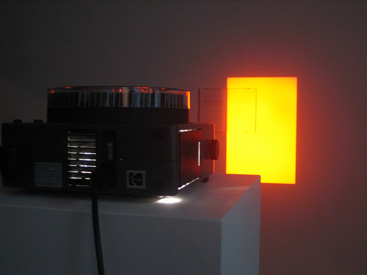
Born in 1977 in Vitry-sur-Seine (FR). Lives and works in Paris (FR)

2008
Installation, book, 81 slides
Dimensions variables
Livre 14 x 21,5 cm
Year of Purchase: 2008
Mark Geffriaud’s work is a meeting point of multiple artistic, literary, scientific and, in the broad sense of the word, cultural facts. It is animated by references which function as points of origin accompanying curious and facetious sayings. Assembling a collection of historical or anecdotal stories, without any order of value, it compiles, organizes and articulates them, provokes an encounter, and asks questions. Cultivated and pioneering, this body of work remains nevertheless a place of interpretation and appropriation. Les renseignements généraux (General Intelligence), for example, comprise a book in which a wide range of images seem to illustrate an absent text, an unfinished work which, built around unlikely juxtapositions of reproductions, calls for the construction of a commentary, for personal writing of a text capable of filling in the empty space between illustrations in order to create meaning. Combining an undisguised pleasure of learning with a sense of wonder at the discovery and at repeated reading, Mark Geffriaud’s work remains in a state of permanent incompleteness which welcomes investigation.
Roche (2008) takes as its starting point the debut novel by the protean writer Maurice Roche. In Compact, published in 1966, the writer developed a story for seven narrators. The narrative voices were identified using font colors which mingled and echoed, constructing a singular narrative object with a decisively polychrome plot. Mark Geffriaud’s Roche harks back to Compact and plays with its colorful composition in order to enter into a dialogue with the novel.
The artist establishes a device enabling the dissociation of voices by juxtaposing the polychromy of Maurice Roche’s writing and the use of monochrome (thereby alluding to an important practice in recent history of art). A set of monochrome slides (blue, red and orange) is projected onto the pages of the book, erasing, by chromatic homonymy, certain passages. Paradoxically, light―which constitutes the work’s theatrical element―effaces the work at the same time. The artist intervenes through a series of slides in order to re-orchestrate writing, letting sentences appear or disappear; he creates depth, multiplies intensities and nuances, underscores juxtapositions, and unveils the text. He reworks it relentlessly, relying on a large variety of slides which, either by erasure or emphasis, recompose the text with each passage and thus create novel sequences. The monochrome becomes an instrument of mixing and cutting; it takes on a cinematic dimension. At the same time, the slide projection fosters a form of classification which, going beyond the narrative question, visually organizes the book and introduces the problematic of plastic composition. Using a rather straightforward mechanism, Mark Geffriaud questions the resistance of a transdisciplinary object. From a certain point of view, Roche may be seen as an artistic response to literary experimentation.
Guillaume Mansart